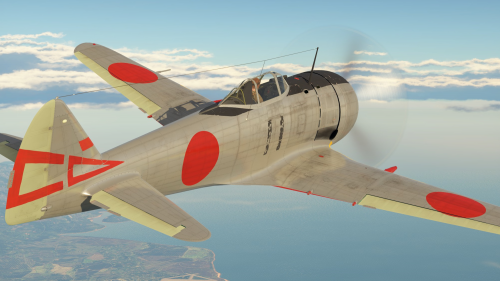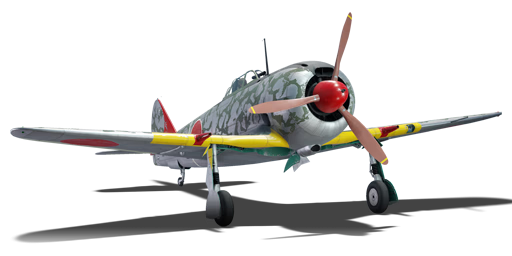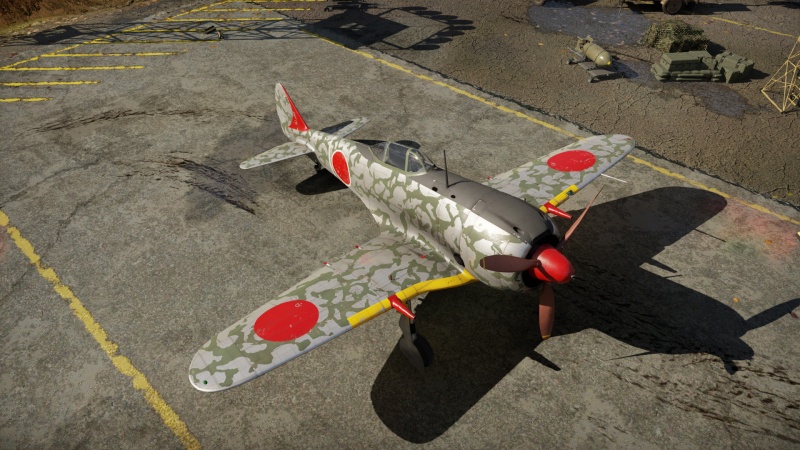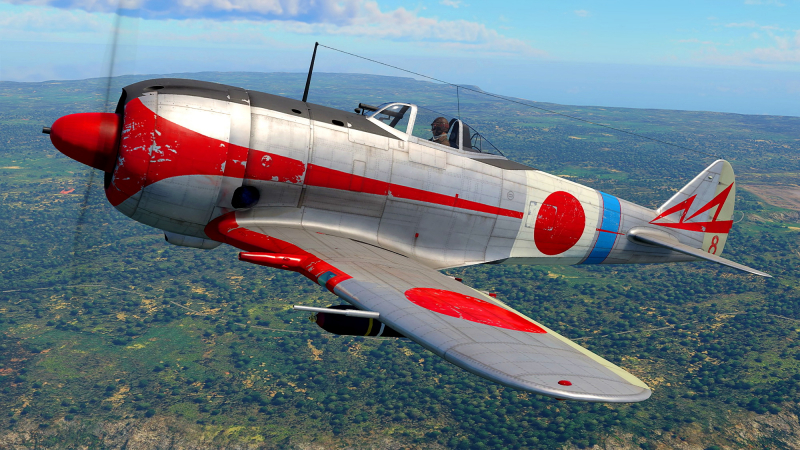Ki-44-II otsu
| This page is about the Japanese fighter Ki-44-II otsu. For other versions, see Ki-44 (Family). |
Contents
Description
The Ki-44-II otsu Shoki is a premium rank II Japanese fighter with a battle rating of 3.0 (AB/RB) and 2.3 (SB). It was introduced in Update 1.55 "Royal Armour".
General info
Flight performance
| Characteristics | Max Speed (km/h at 5,200 m) |
Max altitude (metres) |
Turn time (seconds) |
Rate of climb (metres/second) |
Take-off run (metres) | |||
|---|---|---|---|---|---|---|---|---|
| AB | RB | AB | RB | AB | RB | |||
| Stock | 583 | 565 | 9800 | 21.8 | 22.4 | 13.7 | 13.7 | 320 |
| Upgraded | 634 | 605 | 20.7 | 21.0 | 24.2 | 18.3 | ||
Details
| Features | ||||
|---|---|---|---|---|
| Combat flaps | Take-off flaps | Landing flaps | Air brakes | Arrestor gear |
| ✓ | ✓ | ✓ | X | X |
| Limits | ||||||
|---|---|---|---|---|---|---|
| Wings (km/h) | Gear (km/h) | Flaps (km/h) | Max Static G | |||
| Combat | Take-off | Landing | + | - | ||
| 850 | 250 | 400 | 400 | 250 | ~12 | ~8 |
| Optimal velocities (km/h) | |||
|---|---|---|---|
| Ailerons | Rudder | Elevators | Radiator |
| < 400 | < 400 | < 450 | > 335 |
| Compressor | Optimal altitude | 100% Engine power | WEP Engine power |
|---|---|---|---|
| Setting 1 | 1,386 m | 1,420 hp | 1,613 hp |
| Setting 2 | 4,443 m | 1,300 hp | 1,477 hp |
Survivability and armour
Examine the survivability of the aircraft. Note how vulnerable the structure is and how secure the pilot is, whether the fuel tanks are armoured, etc. Describe the armour, if there is any, and also mention the vulnerability of other critical aircraft systems.
Modifications and economy
Armaments
Offensive armament
The Ki-44-II otsu is armed with:
- 2 x 40 mm Ho-301 cannons, wing-mounted (10 rpg = 20 total)
- 2 x 12.7 mm Ho-103 machine guns, nose-mounted (250 rpg = 500 total)
The twin Ho-103 machine guns are identical in performance to most other Japanese aircraft carrying this type. The air targets belt is recommended in most situations as it carries a great balance of armour piercing and incendiary components along with tracer rounds, not to mention high-explosive rounds, which is very unusual for machine guns. The twin Ho-301 autocannons are devastating to anything which it hits, making short work of most aircraft. The unfortunate drawback with these cannons is that they utilise very low-velocity rounds and will need a large lead on anything being attacked, with a larger lead time the further out the target is.
Suspended armament
The Ki-44-II otsu can be outfitted with the following ordnance:
- Without load
- 2 x 50 kg Army Type 94 GPHE bombs (100 kg total)
- 2 x 100 kg Army Type 94 GPHE bombs (200 kg total)
Usage in battles
Describe the tactics of playing in the aircraft, the features of using aircraft in a team and advice on tactics. Refrain from creating a "guide" - do not impose a single point of view, but instead, give the reader food for thought. Examine the most dangerous enemies and give recommendations on fighting them. If necessary, note the specifics of the game in different modes (AB, RB, SB).
- In simulator, the Ki-44 is a decent fighter that can do traditional dogfights, some bomber-hunting and some ground pounding. It has great all-round visibility, especially to the sides and the rear thanks to its clear teardrop canopy. However there are lots of thick frames at the front which can get very annoying and obstruct the target in a chase, delaying the pilot's reaction. The glass on the canopy's sides also tend to create dizzying reflections when the sun is near, reducing the visibility a lot. The over-the-nose visibility is average. The wing position (in front of the canopy) means that you cannot see anything at your low 11, 12, 1, 2 'o clock so you have to fly past the target area and look towards 3, 4, 5, 7, 8, 9 'o clock where there is nothing to obstruct your view.
- The handling is good in general. During a take off the Ki-44 feels nose-heavy without any flaps deployed therefore after retracting the gears and flaps you need to pitch up a bit until the plane picks up some speed. Only elevator trim is available, so when the stick is at its deadzone, the Ki-44 will roll and yaw to the left side. Therefore you always need to pull the stick to the right which can get a bit annoying. It has excellent climb rate of around 14m/s at 400 km/h, with 100% throttle and no MEC. This means that it can get to an ideal altitude of around 3000m very quickly. In a dive it easily accelerates to around 550 km/h while still having responsive controls, however it does not retain the speed well after leveling out. Note that its engine will overheat unbelievably fast. With WEP it heats up to >243° within 15 seconds. Thus you must utilise the WEP only when you have to, for example in a zoom climb or a high yoyo. The good news is, the engine can cool down quick enough for another 15-second WEP.
- While being more of a BnZ fighter, the Ki-44 also performs excellent at turn fighting - with the appropriate opponent, of course. Except a few dedicated turn fighters, the Ki-44 can out-turn and get on most opponents' tail with combat flaps deployed. Note: do not turn with Spitfires or Zeros, you will never out-turn them. If you see a plane with a streamlined inline engine and large, elliptical wings (Spitfire) or something with rounded wingtips and stabiliser tips, a radial engine and a pointy tail (A6M), try some defensive manoeuvres like barrel rolls or disengage by diving towards a nearby friendly airfield.
- The Ki-44 has a lovely low stall-speed of around 160 km/h and is also very controllable when getting out of a stall. However the handling gets very sluggish when slower than 200 km/h so make sure that there is no one behind you.
- When intercepting planes, it is crucial to know what the target is. If it is a bomber/attacker with decent defensive firepower, great turret coverage, or robust protection, then you might want to disengage after some attempts if you don't want to die. From the hard-hitting M2 Browning to the fast-firing MG 15, any gun can critically damage the Ki-44 especially on the engine, fuel tanks, and pilot which can always lead to a later crash. Before attacking try to get an altitude advantage and perform deflection shots. To maximise the damage aim for their wings and engines, as the fuselage usually soaks up lots of bullets. Only fire when the bomber passes in front of your guns. This short window might seem inadequate to do anything... and it usually is, unfortunately. The slow velocity, light projectiles and low one-second burst mass usually guarantee no critical damage. However sometimes it only takes one bullet to set the target aflame, if you are lucky.
- B-25, Ju 88, IL-2, etc: These aircraft have either powerful defensive guns, for example the B-25, or wide gun coverage such as the Ju 88. The most threatening one, the B-25, is fairly easy to distinguish. It has a short and wide fuselage, twin radial engine hanging under the wings and a H-tail. Focus your fire on the engines and constantly swing sideways to avoid getting hit. A few hits from the M2 Browning is a guaranteed death. The Ju 88, on the other hand, has great underside gun coverage so attacking from below isn't a very good option. Try engaging from the sides and concentrate the fire on the front half of it, as that is where all the vital components are located. Again, never engage any of these if you have no altitude advantage. Pin them on the map and leave them to teammates with more powerful firepower.
- A6M, Spitfire, etc: If you see them on your tail try outrunning them by diving at around -40 degrees. The Ki-44 still remains responsive handling at 600 km/h, but its speed retention is poor, meaning it will start to lose speed quickly and the enemy might catch up. If you are near a friendly airfield, great. If not, then hope for the best and run towards the friendly side. Don't forget to pitch up and down a little to mess up their aim, the early Spitfires and A6M only have a 60-round drum per cannon which will run out fairly fast. The leftover 7.7 mm machine guns will not be as destructive.
- F4U, F6F, P-47, etc: these planes are a huge threat to the Ki-44 as they have superior firepower, speed, dive acceleration and robust airframes. Their 12.7 mm MGs can easily tear you apart or simply pilot-snipe you even when they are far away, as the M2 Brownings have great velocity and trajectory. They can also set you aflame easily. The F4U has a long cylindrical nose and the iconic inverted gull wing. The P-47 has a huge, jug-like fuselage, bubble canopy and elliptical trailing edge that usually have invasion stripes painted on them. The F6F, on the other hand, might get confused with other planes as it looks rather average. Anyways, start a turnfight whenever you see these stubby planes.
Manual Engine Control
| MEC elements | ||||||
|---|---|---|---|---|---|---|
| Mixer | Pitch | Radiator | Supercharger | Turbocharger | ||
| Oil | Water | Type | ||||
| Controllable | Controllable Not auto controlled |
Controllable Not auto controlled |
Controllable Not auto controlled |
Separate | Controllable 2 gears |
Not controllable |
Pros and cons
Pros:
- Powerful armament for tough aircraft
- Extremely good acceleration
- Good climb rate allows it to get altitude advantage over most enemies
- 40 mm cannons can be used as impromptu brakes when landing (because of the huge recoil)
Cons:
- Very fragile with next to no protection. Will get shredded/set on fire easily, especially by any plane with M2 Brownings (e.g. F6F-5)
- Engine easily damaged
- 40 mm cannons are very hard to use: extremely low velocity, big recoil and absurdly low ammo of only 10 RPG. This requires strict trigger control
History[1]
Nakajima began development of the Ki-44 in 1940 as a pure interceptor with emphasis being placed on airspeed and rate of climb rather than maneuverability, a departure from the usual Japanese standards. The Japanese Army Air Force specification called for a maximum speed of 600 km/h (370 mph) at 4,000 m (13,130 ft), to be attained in five minutes. A set of Ki-43-like "butterfly" combat flaps was fitted for improved maneuverability. Armament consisted of a pair of 7.7 mm (.303 in) and a pair of 12.7 mm (.50 in) machine guns.
The engine selected for the new interceptor was Nakajima's Ha-41 (a development of the Nakajima Ha-5) 14-cylinder double-row radial, originally intended for bomber aircraft. Although the Ha-41 was not the ideal choice due to its large-diameter cross section, the design team was able to marry this engine to a much smaller fuselage with a narrow cross section. At 1,260 mm in diameter, the Ha-41 was 126 mm larger in diameter than the 1,144 mm Nakajima Sakae (used in the Mitsubishi A6M "Zero" and Nakajima Ki-43 "Hayabusa"). However, the Sakae was only 27.8L in displacement and 1,000 hp, while the Ha-41 was 37.5L and made 1,260 hp (1,440 in the later Ha-109 version). In any case, since the Sakae wasn't powerful enough, the only alternative available was the Mitsubishi Kinsei, which was slightly smaller than the Ha-41 in diameter, five liters smaller in displacement, and was less powerful. Unfortunately, this was already in demand for many other aircraft, so the Ha-41 was chosen as the best powerplant. In order to achieve its design goals, the wing area was relatively small leading to a high wing loading and a comparatively high landing speed that could be daunting to the average Japanese pilot, who was more used to aircraft with a low wing loading like the Ki-44's predecessors, the Ki-43 and Ki-27.
With an all-metal structure, the Ki-44 was metal-skinned except for the control surfaces, which were fabric covered. Relatively small wings gave the aircraft a high wing loading and consequently a high landing speed, which many pilots disliked.
The first Ki-44 prototype flew in August 1940 and the initial test flights were generally encouraging, with handling considered acceptable considering the high wing loading. Problems encountered included a high landing speed and poor forward visibility during taxiing due to the large radial engine.
The Nakajima Ki-44 at one point equipped 12 sentai ("groups/wings") of the Imperial Japanese Army Air Force: 9, 22, 23, 29, 47, 59, 64, 70, 85, 87, 104 and 246 Sentai. The Manchukuo Air Force also operated some Ki-44s.
Pre-production Ki-44 aircraft and two of the prototypes were turned over to the Army for service trials on 15 September 1941. The type commenced operations when nine aircraft were received by an experimental unit, 47th Chutai "Kawasemi Buntai" ("Kingfisher Flight, 47th Squadron"), commanded by Major Toshio Sakagawa at Saigon, Indochina in December 1941.
The Ki-44 also saw significant action with 87th Sentai in the air defense role, while based at Palembang, Sumatra. Other units equipped with the Ki-44 during the early part of the war were stationed in China, Burma, the Philippines and Korea.
Later in the war, the type saw action in an air defense role over the home islands – mainly around Japan's large industrial cities. 47 Chutai, after it was transferred to air defense roles in Japan, was expanded to become 47 Sentai.
During 1946–49, both sides in the Chinese Revolution operated Ki-44s surrendered or abandoned by Japanese units. Air units of the People's Liberation Army obtained aircraft formerly belonging to 22 and 85 Sentai, which had disbanded in Chosen. Some of these aircraft were reportedly flown by Japanese veterans. Within the Republic of China Air Force 18th Squadron (12th Fighter Group) was equipped with Ki-44s formerly of 9th Sentai, which had disbanded in Nanking, and 29th Sentai, which had disbanded at Formosa and they saw action in . Following the retreat of the Nationalists the People's Liberation Army Air Force (formed in 1949) used the Ki-44 until the early 1950s.
No complete surviving examples of the Ki-44 exist today. However, a wing center section is preserved at the Northwestern Polytechnical University Aviation Museum, at Xi'an in China.
Media
- Skins

See also
Links to the articles on the War Thunder Wiki that you think will be useful for the reader, for example:
- reference to the series of the aircraft;
- links to approximate analogues of other nations and research trees.
External links
Paste links to sources and external resources, such as:
- topic on the official game forum;
- other literature.
| Nakajima Aircraft Company (中島飛行機株式会社 ) | |
|---|---|
| Fighters | Ki-27 otsu · Ki-27 otsu Tachiarai |
| Ki-43-I · Ki-43-II · Ki-43-III otsu | |
| Ki-44-I · Ki-44-I 34 · Ki-44-II otsu · Ki-44-II hei | |
| Ki-84 ko · Ki-84 otsu · Ki-84 hei | |
| Ki-87 | |
| Hydroplanes | A6M2-N* |
| Interceptors | J1N1 · J5N1 |
| Bombers | B5N2 |
| B6N1 Model 11 · B6N2 Model 12 · B6N2a Model 12Ko | |
| G5N1 · G8N1 | |
| Ki-49-I · Ki-49-IIa · Ki-49-IIb · Ki-49-IIb/L | |
| Recon | E8N2 |
| Jet Fighters | Kikka |
| Captured | ␗Ki-27 otsu · ▃Ki-43-II · ␗Ki-43-III ko · ␗Ki-44-II hei · ␗Ki-84 ko |
| *Refit of the Mitsubishi A6M2 mod. 11 | |
| See also | Fuji Heavy Industries (1957-2017) |
| Japan fighters | |
|---|---|
| Navy | |
| Carrier-based fighter | |
| A5M | A5M4 · Hagiri's A5M4 |
| A6M | A6M2 mod. 11 · A6M2 · A6M3 · A6M3 mod. 22 · A6M3 mod. 22Ko · A6M5 · A6M5 Ko · A6M5 otsu · A6M5 Hei · A6M6c |
| A7He | A7He1* |
| A7M | A7M1 (NK9H) · A7M2 |
| Land-based Fighter | |
| J2M | J2M2 · J2M3 · J2M4 Kai · J2M5 · J2M5 (30 mm) |
| J6K | J6K1 |
| J7W | J7W1 |
| N1K-J | N1K1-Ja · N1K2-J · N1K2-Ja |
| Fighter seaplane | |
| N1K | N1K1 |
| A6M-N | A6M2-N |
| Army | |
| Ki-10 | Ki-10-I · Ki-10-I C · Ki-10-II · Ki-10-II C |
| Ki-27 | Ki-27 otsu · Ki-27 otsu Tachiarai |
| Ki-43 | Ki-43-I · Ki-43-II · Ki-43-III otsu |
| Ki-44 | Ki-44-I · Ki-44-I 34 · Ki-44-II otsu · Ki-44-II hei |
| Ki-61 | Ki-61-I ko · Ki-61-I otsu · Ki-61-I hei · Tada's Ki-61-I hei · Ki-61-I tei · Ki-61-II Otsu Kai |
| Ki-84 | Ki-84 ko · Ki-84 otsu · Ki-84 hei |
| Ki-87 | Ki-87 |
| Ki-94 | Ki-94-II |
| Ki-100 | Ki-100 · Ki-100-II |
| Other countries | ▅F4U-1A · ▅P-51C-11-NT · ▅Bf 109 E-7 · ▅Fw 190 A-5 |
| *Imported designation of the He 112 (A6M was in development - A7M would take A7 designation after the cancelation of the A7He) | |
| Japan premium aircraft | |
|---|---|
| Fighters | Hagiri's A5M4 · A7He1 · Ki-27 otsu Tachiarai |
| Ki-44-II otsu · ▅Bf 109 E-7 · ▅F4U-1A · Ki-100-II · Ki-44-I 34 | |
| ▅Fw 190 A-5 · A7M1 (NK9H) · Tada's Ki-61-I hei · ▅P-51C-11-NT | |
| J2M4 Kai · A6M5 Ko · A6M6c · J2M5 · Ki-87 · J6K1 | |
| Twin-engine fighters | Ki-96 |
| Jet fighters | F-86F-40 JASDF▅ · T-2 Early · F-4EJ ADTW |
| Strike aircraft | ▄AV-8S |
| Bombers | Ki-21-I hei · Ki-48-II otsu · H8K3 · B7A2 (Homare 23) · ▅B-17E |






